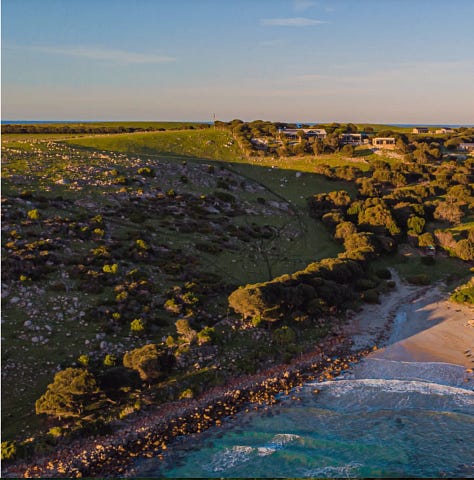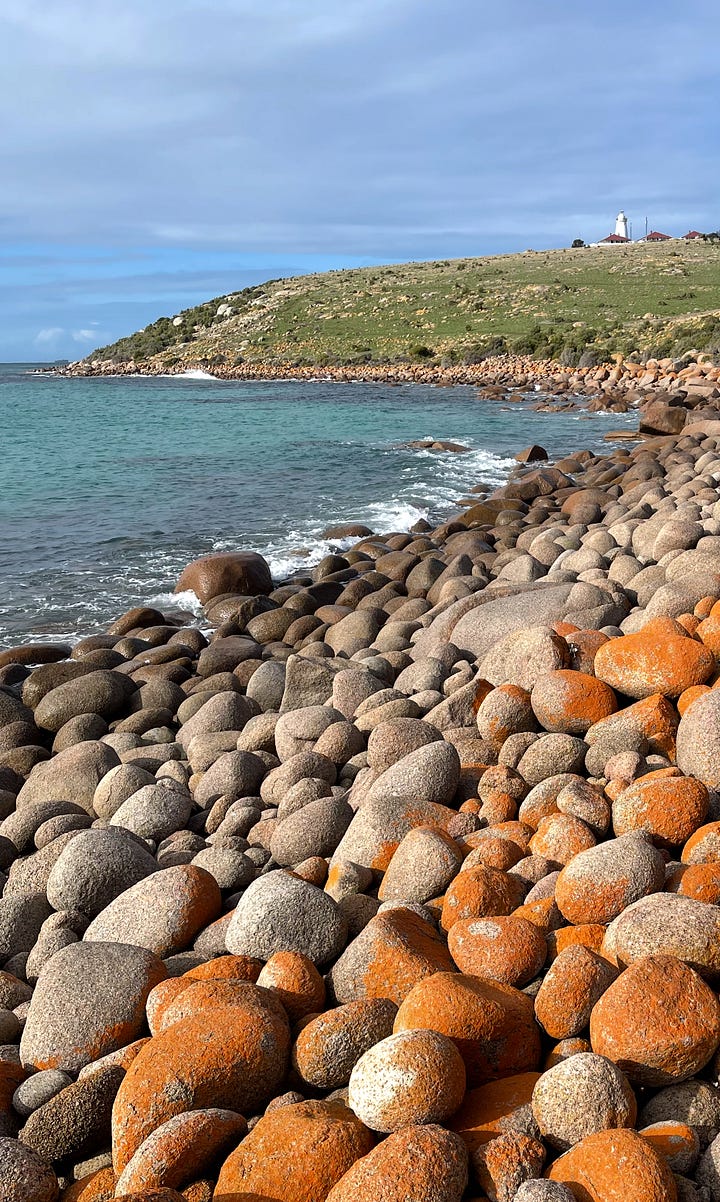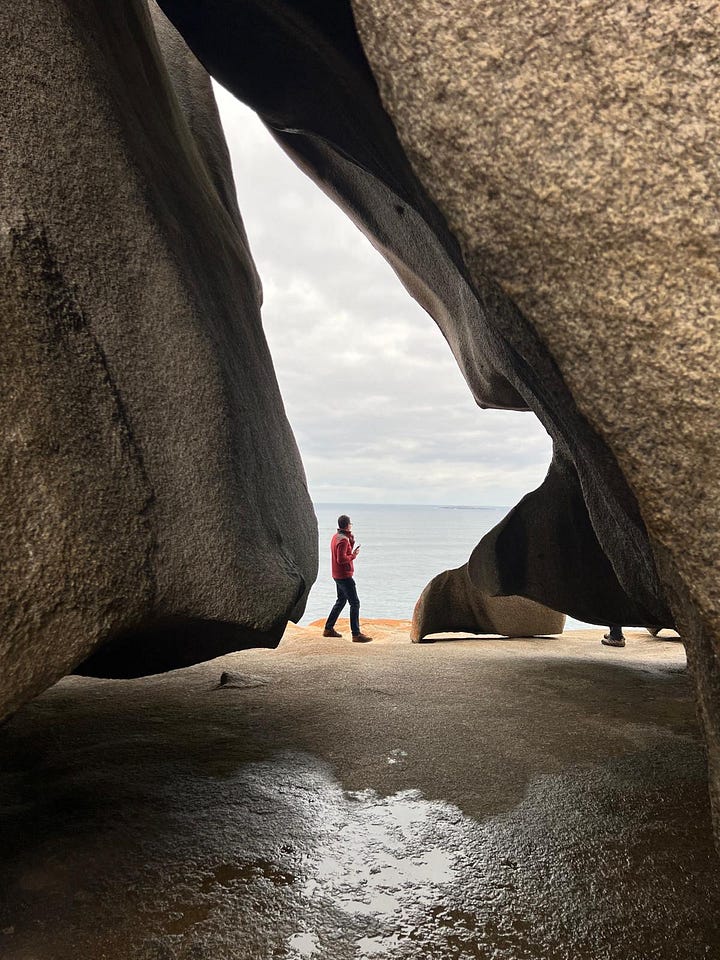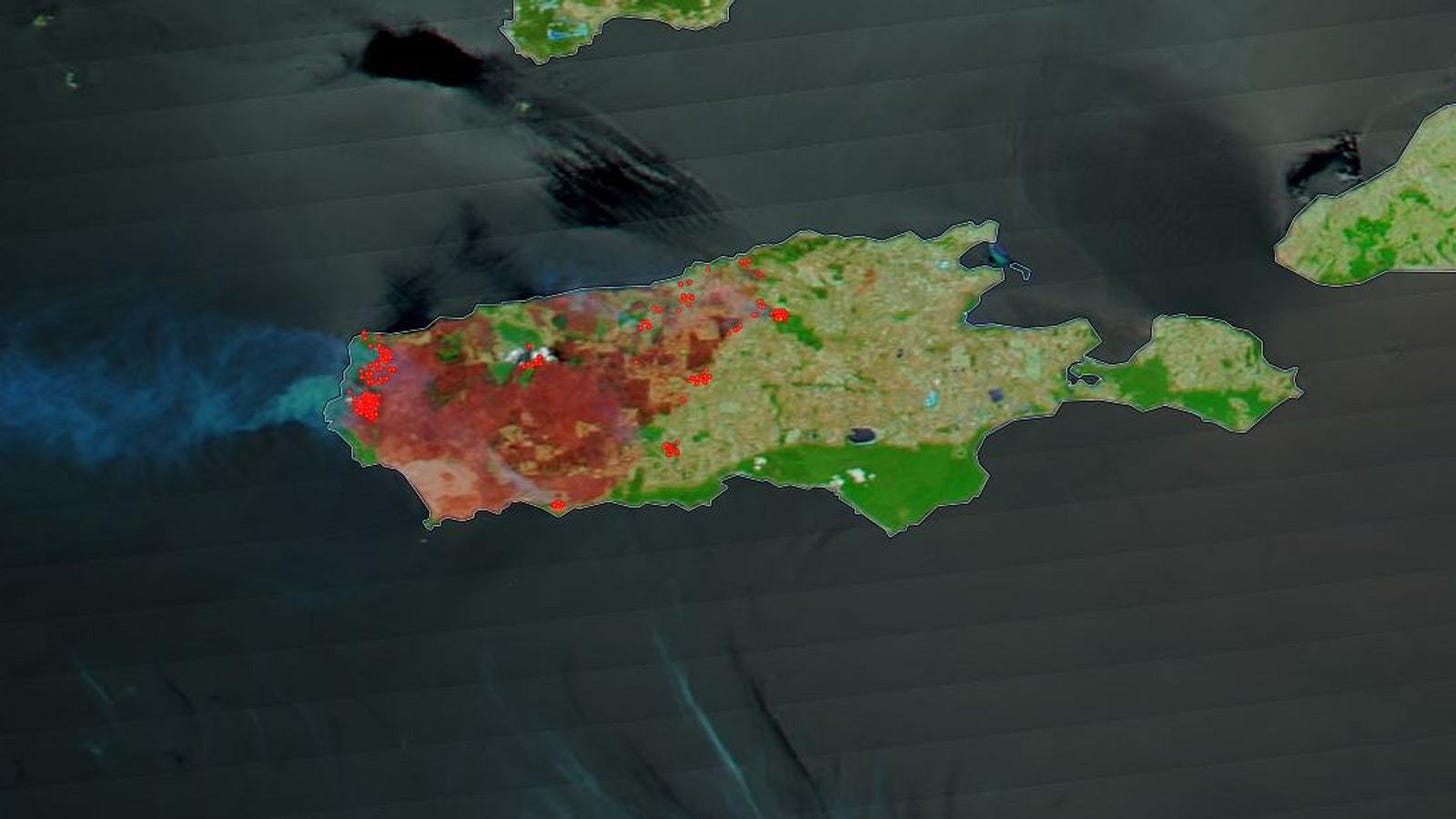The wonder of nature that is Kangaroo Island
SOUTH AUSTRALIA: Five years after the fires, this place offers a master class in resilience, regeneration and relaxation.
The small plane banked abruptly as if the pilot had to make a last minute correction. We were only 20 minutes in the air from Adelaide before Kingscote’s runway came into view. The fading winter light was turning the sky a bruise-blue.
To land at dusk was courting danger, especially if you were planning on self driving. At least this was the implied message from the man behind the rental-car desk at the airport. He was adamant: “Please limit the amount of driving at night.” He hinted at the active wildlife, and sure enough, less than 5 kilometres on the road my first close encounter hopped into view. It was a near miss, but a brutal confirmation of his warning.
Matthew Flinders, this nation’s first circumnavigator, ascribed Kangaroo Island (KI) its moniker because of the vast number of macropods (both kangaroos and wallabies) he observed when mapping Australia’s shoreline. This was in 1802. The term comes from the Greek words makros (large) and pous or pod (foot), literally meaning “large foot”.
Flinders did not see any First Nations people, even though evidence of their presence dates back 16,000 years. Archaeological studies suggest the last of the local indigenous Kartan population vacated the island around 2,000 years before Europeans arrived. According to the Kartan’s oral tradition, Kangaroo Island was known as Karta Pintingga – Island of the Dead – suggesting it held symbolic or sacred meaning, possibly as a burial place or where spirits passed on.
There is no definitive explanation for their departure but certainly a contributing factor was likely rising sea levels following the last ice age around 10,000 years ago, which submerged the land bridge connecting what’s now KI to the mainland.
Today’s Sealink ferry plies the 15-kilometre route between Cape Jervis and Penneshaw in about 45 minutes. Costs are around $130, depending on the season, for a standard vehicle. Walk-on adult passengers pay about $60 one way.
Having been so starkly confronted by that initial roo encounter, the drive east in fading light towards the Dudley Peninsula was cautious and full of concentration. The edges of the road were alive on both sides with movement: wallabies and roos streaking across the asphalt, while possums would pause mid-dart to stare back with luminous eyes into my headlights. The edges of the road were also littered with roadkill.

Then the bitumen soon turned to dirt, which made driving even more precarious as you had to navigate corrugations and potholes too. There was little to no traffic. Which makes sense given the kamikaze night-time wildlife. I wound the window down. The cool, clear air carried a hint of eucalyptus.
In that ink-black light beyond the glare of headlights, Kangaroo Island felt like a wild promise: equal parts invitation and warning. I drove slowly, with Cape Willoughby my final destination this first night.
In the space of a few hours, I’d left behind the urban burden of capital city traffic snarls, Zoom meetups and harried catchups; swapping concrete canyons for unbroken dark. One moment I was threading through city streets, the next I was shoulder‐deep in silence, interrupted only by the thump of tyres on a gnarly unsealed gravel road.
This shift felt almost absurd: How a twenty-minute flight and a short, but intense drive can carry you from neon glare to a place where the only illumination is your headlights, and the only rhythm is your pulse.
With the main built-up settlements of Kingscote and Penneshaw in my rear view mirror, navigation became another complication. Road signs are rare and small, or give you very little notice of what’s in store. Then the mobile coverage ceased. Google Maps gone.
After several missed driveways and turns I eventually found my way to Sea Dragon Lodge. Dinner and breakfast included. Both were divine across my stay, especially the green ant tart for dessert that first night, which was made more appetising by a glass of local riesling. I’m not a white wine drinker for the most part, but Leo the loquacious reception worker, bar tender, food waiter, concierge, wine connoisseur, and night manager, convinced me that this local drop from nearby False Cape was “not your normal riesling style”.



He explained that the maritime climate with its offshore breezes by day, and cooling air by night, imparts a crystalline acidity that elevates the lemon-zest aromatics. Maybe he says that to all the guests, but it worked on me. I was too frazzled from the tense drive to query his enological smarts or otherwise. In my glass, I tasted sharp lime peel, a hint of coastal saline minerality, with a long dry finish. It all cut through the richness of my green ant tart beautifully.
In contrast, a typical South Australian Clare or Eden Valley riesling tends to lean more toward lemony, floral aromatics and occasional stone-fruit notes like green apple and white peach. They can brim with bright citrus acidity, but less of that coastal salinity. Leo said something when he topped up my glass about how the vineyard’s Terra Rosa soils over limestone, and proximity to the island’s South Coast, add a distinctive mineral quality and intensity to the fruit. Or something like that.
Morning brought strong winds and fleeting rain storms. Neither were a deterrent to exploring the south eastern corner of the island. Daylight also brought context. Beyond the end of my bed, down a step and past the lounge, through the sitting area, out the sliding double-glazed doors, across the private deck and through the eucalypt was Pink Bay in all its pristine and wild beauty.
So named on account of the pink colouring of the abundant granite rocks found in the area, it’s a short downhill walk from Sea Dragon. Facing due north, the tiny beach tends to miss much of the nasty weather and swells that frequent this corner of the Southern Ocean, making it one of the ‘least hazardous’ swimming spots on the entire island. But stay close to shore if you venture in: these waters are famous breeding and hunting grounds for Great White sharks.


A short walk from the lodge leads to Cape Willoughby and the oldest lighthouse in South Australia. At the eastern extremity of the island, it marks the entrance to Backstairs Passage, the notorious stretch of water separating Kangaroo Island from the mainland. The lighthouse, various keepers’ cottages and adjacent heritage walks all fall within a popular conservation reserve. Many marsupials included.

Later, I checked out the source of that fabulous riesling: False Cape winery. Driving on unsealed roads is a totally different proposition in daylight. And most of the roads on the Dudley Peninsula—once you leave the main town of Penneshaw—are unsealed.
It was a Monday in winter; the quietest day of the week, amid the slowest season of the year, and yet there were plenty of people lunching and lounging around the winery’s cellar door. Leo had tipped me off about their famous home-made pies, but I was not hungry so did not inquire.
Fun [sustainability] facts:
False Cape is entirely off-grid
Reds are dry grown
Free-range turkeys roam the vineyard for pest control
Sheep manage weeds in winter and encourage biodiversity.
Knowing I had a stint of self catering to come later during my stay, I stocked up on some of that riesling. But that’s not all. I’m normally not a sucker for an up-sell, but the sales person had me at “fortified shiraz”. The tasting sample carried dark-cherry sweetness threaded with prominent notes of blackberries and spice, like a rich fruit cake. A hint of brandy lingered on a smooth finish. Leo didn’t mention any of this.
Following a few nights in the far east, I went west along Kangaroo Island’s southern shore. After several welcome hours of driving on bitumen, the first stop was Seal Bay Conservation Park.
The air is salted with sea spray. Seagulls cry overhead. The wind moves swiftly in from Antarctica, forcing foliage to bend and lean away in self defence. There is a serpentine boardwalk that cuts through shifting sand dunes of mallee scrub and saltbush right to the beach. It is built so anyone can come: wheelchairs, children in prams, older people with bad knees and walking frames. You can watch the sea lions from above, safe and unseen, or join a guided group and walk the beach itself.
This species of sea lions (Neophoca cinerea) is endemic to Australia and is considered endangered, with Seal Bay being home to the third largest colony in the country, numbering around 800 individuals. There are two breeding nurseries at either end of the beach.
They sprawl in the sun as if it is their own living room, seemingly unbothered by the presence of humans. Nursing mothers can rest in the same spot on the sand for days after exhausting themselves hunting for food to replenish their milk supplies, sometimes for up to 10 to 20 continuous days at sea.
Big bulls with scars and thick necks growl loudly. Pups with eyes still wide with wonder, waddle on all four ‘flippers’ in their mother’s wake. Others doze in the dunes, their hides glistening in the soft winter sun. Wherever you look the colony is alive, breathing, moving, snorting, grumbling. It’s like stepping into the home of an extended family.
In the gentle rolling waves, some pups are having swimming lessons. It’s safe from predators here. A series of outlying reefs act as a natural defence against sharks as well as whalers and seal hunters in centuries past.
There are no cages. No bars. Just the open air and the wild sea. If you baulk at the notion of a guided tour; don’t. The rangers have names for old bulls, and mothers with their pups. They tell fascinating stories of the sea, of storms and hunting and animal conservation. And only on a guided tour can you access the beach directly, stepping lightly, careful to follow instructions, and not to disturb the sea lions.
The next hour or so on the road was a blur. Not from driving into a setting sun, but the recollections of what just happened at Seal Bay. You saw life, untamed and indifferent, and for a brief moment, you were part of it. And then the sight of rotting roadkill brings you back to reality.
It’s also here in the western half of the island that you see the ravages of those fires.
In the summer of 2019/20, Kangaroo Island endured one of Australia’s most devastating bushfire seasons. The fires, ignited by lightning strikes just prior to Christmas, first took hold in the north, then spread to the heart of the island and, 10 days later, into Flinders Chase National Park. Over several weeks, the flames raged across the landscape, fuelled by strong winds and extreme heat.
By early February, when the fires were finally declared ‘under control’, almost half of the island’s 440,500 hectares had been burned. The worst of the impact was felt in the western and southern regions, with Flinders Chase National Park losing about 95% of its area.
The environmental toll was profound. Almost 60,000 livestock perished, and an estimated 25,000 koalas and countless other native animals lost their lives or their habitats. Key species such as the endangered Kangaroo Island dunnart and glossy black cockatoo faced critical habitat loss. Across the island, farms, forests, crops, and infrastructure were devastated.
Five years later, and the rebuild and regrowth is well underway with community volunteers and state rangers having lead multiple and ongoing regeneration projects. This included planting thousands of seedlings, erecting predator-proof fencing, and monitoring vulnerable species.
But the evidence of the firestorms is stark. Blackened tree trunks and limbs, stripped bare of life, protrude eerily above the regenerating scrub, like spindly grey fingers reaching upward. These trees are not dead. They are a vital ‘host’ for the emerging undergrowth.
One famous infrastructure casualty of the fires was the iconic Southern Ocean Lodge. It was razed to the ground.
Miraculously, it’s been rebuilt. For original co-owner Haley Baillie (along with husband James), the feeling after the fire was “gut-wrenching.” Do you start again? That is, in a changing climate, can you safely and sustainably co-exist in wild locations like this?
The answer for both Baillies was ‘yes’. “We’ve got this blank canvas,” says Hayley, “… to do this again.”
Conveniently, the lodge’s owners at the time, private equity firm KSL, also agreed. KSL, which operates luxury resorts around the world, stumped up about A$50m for the cutting-edge eco-friendly and disaster-resilient rebuild. Adelaide architects Max Pritchard (who was born on the island) and Andrew Gunner designed the original lodge. They got on board again, because as Pritchard admits: “We can always do better.”
And they have, with the main adjustment being a realignment of the orientation of the low-set accommodation along the ridge line “to get the maximum benefit from the super view down the coast.” Some of the 25 suites (up from 21) now have their own infinity plunge pool.
So, with brief stops at Vivonne and Hanson Bays after Seal Bay, I drive to my next stay: Southern Ocean Lodge 2.0.
The first incarnation of the lodge won just about every luxury resort poll conducted in the world. Opulent 5-star accommodations, matched with gourmet meals 3 times a day, and a host of signature guided excursions. All inclusive. Top shelf across the board. A 24-hour open bar operates in the Great Room (see pic below). Rates start at about A$3,000 per night.
My self-driving arrival coincided with lunch. Three courses, each with matching wines. After that, I waddled to the room to unpack, then headed out on the first of many ranger-led adventures: the kangas and koala tour at dusk, which concluded with venison canapés and a selection of local wines or beers as we gathered around a warming fire pit in a safe clearing, deep in the bush.

And this routine—fine dining interspersed with outdoor activities and long luxurious sleeps—pretty much summed up my 3 days at the lodge. Just as I checked out (almost 2 kilos heavier), Katy Perry and her entourage checked in. Bill Gates and a host of other notable celeb types have also been guests at Southern Ocean Lodge over the years.
Flinders Chase National Park is a short drive from the lodge. It is here you can see up close the impact of those fires. The place felt wounded. But hope beckoned everywhere with nature slowly regaining her place, under much guidance from local authorities.
Some trees stood black and hollow, stripped bare. Others had begun to sprout again, green shoots pushing through once ashen soil. The silence here felt heavier, like the land was still catching its breath. But there was something steady in the way the plants and scrub were returning. It didn’t feel like recovery exactly. More like endurance. Something quiet and ongoing, just beneath the surface.
In and around the national park are a host of attractions; most in close proximity: Admiral’s Arch (fur seals included), Cape du Couedic lighthouse, and the Remarkable Rocks, to name a few.


Having explored the south-western tip of the island it was time to make tracks. My route was guided by fuel availability, as in where I could fill the tank of my rented Subaru Forester. Service stations are few and far between, and while distances are not large, I wanted to err on the side of caution. That meant heading to my final stop on the north shore via Parndana, a small hamlet smack bang in the middle of the island. It was from here in the first weeks of 2020 that many of the volunteers co-ordinated resources, equipment, and evacuations during the fires.
Away from coastal dunes, the landscape gave way to undulating farmland stretching to the horizon. Lush green paddocks housed very happy livestock. Eucalypts lined the road. At Parndana, I paused at Dave’s Deli, like an old-fashioned general store, for fuel and a ham-and-cheese toastie.
With stomach and tank filled, I was back on unsealed roads again, but not the blonde-coloured gravel of the eastern part of the island, which had been quarried from coastal dunes with their quartz-rich sands, and crushed limestone. In contrast, central and northern KI was red-dirt country, more like central Australia. Much finer dirt, and not as coarse as those east coast roads. The red colour arises from oxidation within the Stokes Bay iron-rich sandstone, which supplied much of the road base in this part of the island.
A brief stretch of bitumen along the Playford Highway interrupted the unsealed road to Stokes Bay and the north coast. The beach here on arrival smelled of rotting seaweed. But then I noticed a subtle sign pointing: “Beach this way”. Long ago, locals cleaved a narrow tunnel through a limestone bluff at the eastern end. You clamber through a maze of contorted and confined passageways before emerging (with some relief) on to Australia’s Best Beach. At least, that was the view of Tourism Australia in its 2023 annual awards.
Judges noted Stokes Bay’s “secluded, family-friendly atmosphere, stunning tidal swimming pools, and unique entrance through a labyrinth of rocks.” It was the combination of these unique features that apparently set it apart. I’d have to agree. But there is a caveat: the location and shape of that ‘stunning tidal swimming pool’ has created a permanent and very hazardous rip in the adjacent surf. Signs warn of the danger.

In winter however, there is very little to entice visitors to stay and linger. The caravan and camping area near the smelly beach was empty. The Rockpool Cafe adjacent to the beach carpark was closed. I moved on.
Further north, Snelling Beach unfurled in a wide, windswept arc. Waves rolled in with steady insistence. These beaches rely on respectful visitation: signs implore no litter, no off-trail wandering, no drone flights disrupting nesting birds. Local conservation groups run dune-restoration projects, replacing marram grass with indigenous species to preserve the island’s delicate ecosystems.
On top of the hill overlooking the beach was my final stay: a self sustained, off-grid, self-catering eco pod. Firewood included, as was the small bottle of Kangaroo Island gin. And those False Cape wines I picked up earlier to while away the time. My idea of bliss.
No voices. No houses. Just paddocks and bush and sky and wind. And gin. Trees lean into the breeze and stay there. Kangaroos graze without looking up. The land rolls toward the ocean, but you don’t hear the water, only the stillness between gusts. Flimsy clouds move like smoke across the sky. There is nothing to do here, and that feels right. You sit. You watch. You forget what time it is. The world feels far off, like something you left behind without meaning to. You don’t miss it. Not yet. Not while this serenity holds.
Three days and two nights of this. G&Ts on the deck for sundowners. A tasty tipple. Distilled in tiny copper stills at a nearby local farm, it’s infused with native botanicals like sea parsley and coastal daisy bush, plus Asian peppers for a briny, herbal edge. You sense the salt breeze in each sip. Small-batch runs ensure every bottle carries its birthplace in its aftertaste.
Then a small mob of Tamar wallabies casually amble by. I go inside and light the fire.
And just like that, it was time to leave. I don’t often feel reluctant to depart a place, an experience, a city, an event, a country, or an encounter, but Kangaroo Island somehow felt different, in the sense that it reminds and inspires you to consider an alternative, slower way of living: one that encourages a better balance between the natural environment and how you might co-exist within it more peacefully and sustainably.
Then “ping,” went the Qantas app on my phone with a reminder of my upcoming mid-morning flight from Kingscote.
The road east ran empty in the morning light. The land moved past slowly—scrubby gums, bays catching the sun, and patches of regrowth where the fires had torn through. The trees and mallee and animals were coming back.
I thought of the quiet walks, the sea-lions folded into the dunes, the citric edge of that False Cape Riesling. I thought of clifftop meals and fireside reads. That’s what stays with you: the contrasts. Burnt forests and new green growth; luxury and simplicity; isolation and welcome. Nothing forced, nothing in competition.
Kangaroo Island doesn’t ask for attention. That just comes naturally. What it gives you is space, and time, an overdue reconnection with country, and a compelling invitation to return.








